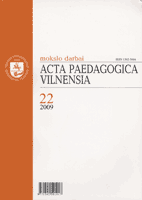STATISTICAL TENDENCIES OF WOMEN’S AND MEN’S SCIENTIFIC CAREERS IN LITHUANIA AND FINLAND: COMPARATIVE ANALYSIS*
MOTERŲ IR VYRŲ MOKSLINIŲ KARJERŲ TENDENCIJOS LIETUVOJE IR SUOMIJOJE*
Author(s): Giedrė Purvaneckienė, Aurelija NovelskaitėSubject(s): Education
Published by: Vilniaus Universiteto Leidykla
Keywords: lytis1; mokslinė karjera2; moters mokslinė karjera3; Europos Sąjunga4;
Summary/Abstract: The paper is devoted for comparative analysis of women’s and men’s participation in two rather different scientific communities such as Lithuania and Finland. Tthe aim of the paper is two-fold. First, to evaluate Llithuanian situation in the context of other country. Comparison of Lithuanian the paper is devoted for comparative analysis of women’s and men’s participation in two rather different scientific communities such as Lithuania and Finland. Tthe aim of the paper is two-fold. First, to evaluate Llithuanian situation in the context of other country. Comparison of Lithuanian and Finnish situation in the context of gender equality achievements in the country. The comparison is trying to answer a question about effect of focused gender equality policy onto women’s involvement into scientific community in general and, more specifically, about women-scientists’ possibilities to achieve the highest levels of academic hierarchies.three main sources of statistical data were used: on the national level – information from statistical data base on Lithuanian scientists as well as statistical information published by national dept. of statistics, and (b) KOTtA – statistical data base on Uuniversities Finland; on international level, – statistical informatikon which was published by European Commis¬sion in 2003 and 2006. Analysis of the materials demonstrates, in general, both Lithuanian and Finnish scientific communities experienced rapid feminization around 2000. Howe¬ver, despite the feminization was faster in Lithuania and women composed slightly larger portion among scientists in all fields of science in the country, Fin¬land was doing better in terms of women-scientists’ achievements reaching the highest levels of natio¬nal academic hierarchy. Credible explanations of the similar tendencies of feminization and different achievements of women scientists in two countries are different. that is, the main reason behind femini¬zation in Lithuanian (as well as in other post-soviet countries) scientific community is diminished status of science in the society (unattractiveness of scienti¬fic careers, men’s retreat from the field). Supposedly, feminization of Finnish scientific community was a direct outcome of active gender equality focused po¬licy in the field and in the country in general.
Journal: Acta Paedagogica Vilnensia
- Issue Year: 2009
- Issue No: 22
- Page Range: 128-141
- Page Count: 14
- Language: Lithuanian

